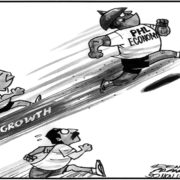WHILE Europe continues to struggle with an economic crisis and the Republicans and Democrats in the House of Representatives are still locking horns over what to do with the looming “fiscal cliff,” the Philippines is experiencing a sunnier side in the economic scene.
The country is currently the best performing nation in Southeast Asia, exceeding expectations with a 7.1 percent growth in its gross domestic product (GDP) in the third quarter year-on-year.
Just a few weeks ago, the International Monetary Fund (IMF) raised its growth outlook for the country to more than 5 percent, “citing its sound fiscal and monetary policies,” reported Inquirer.net.
“We are well on our way to surpassing our growth target of 5 to 6 percent this year,” said Socioeconomic Planning Secretary Arsenio Balisacan on Wednesday.
Balisacan said this could pave the way for more jobs and higher incomes for Filipinos, adding that “the growth momentum is expected to continue next year as government works to ease the cost of doing business and as more infrastructure projects under the private-public partnership scheme get underway.”
“Robust domestic consumption and higher government spending have helped cushion the economy from the worst of the global slowdown, while manageable inflation has allowed authorities to keep interest ratesconducive to growth,” reports Inquirer.net.
The peso has become Asia’s strongest currency — up by more than 7 percent compared to the US dollar.
The economic growth spurt was also attributed to good governance by presidential spokesperson Edwin Lacierda, who said that it was brought about by “sustained confidence in the leadership of President Aquino and his administration, which has consistently equated good governance with good economics.”
Finance Secretary Cesar Purisima opined that “the growth rate shows that the economics of good governance, or ‘Aquinomics’ works.”
Budget Secretary Florencio Abad said that the country faces “very fruitful times ahead” and that he expects the growth to remain vigorous in the fourth quarter.
“Public consumption will most definitely stay robust, fueled by high consumption levels during the holidays, continuing investments in public and private infrastructure, and the kick-start of election-related spending this Christmas season,” Abad said in a statement.
However, the Philippines does not exist in a vacuum. According to Balisacan, the looming “fiscal cliff” in the US and the eurozone crisis can still bring adverse effects to the country’s economy.
The Bangko Sentral ng Pilipinas (BSP) said that it will remain watchful of foreign capital inflows in order to manage the country’s inflation.
“The BSP will be careful to calibrate the use of its enhanced policy toolkit to help ensure that domestic aggregate demand price pressures and risks from capital flows are managed,” BSP Gov. Amando Tetangco, Jr. said.
According to officials, a sharp growth rate may cause a sudden increase in foreign portfolio investments, which may become excessive and destabilize the economy.
While an unexpected upsurge in the economy is a major achievement, the Philippines still faces a bevy of challenges in sustaining this “sweet spot.” This small victory should give us the impetus to improve on our weaknesses. Forbes brings them to the forefront: trade freedom, red tape, corruption, personal freedom and tax burden.
(AJPress)







